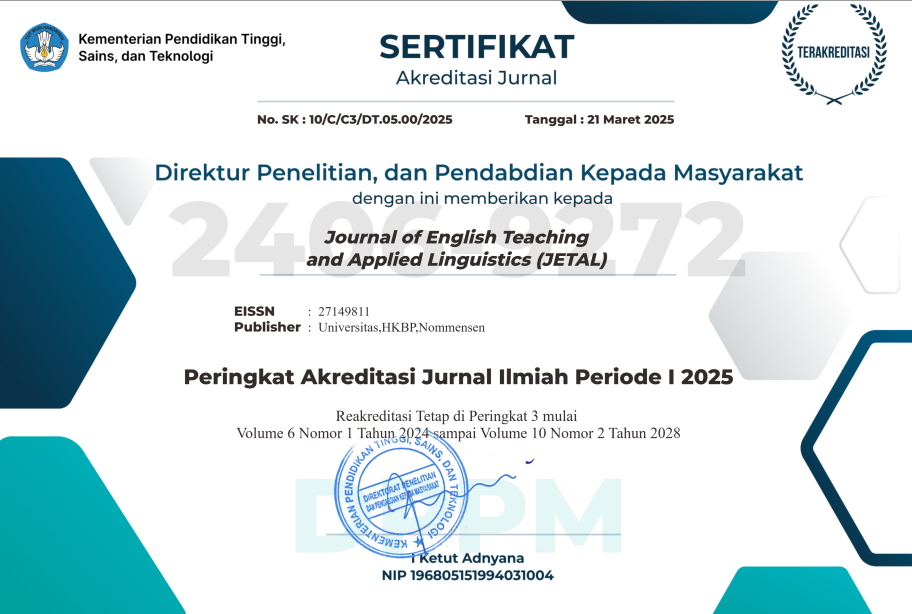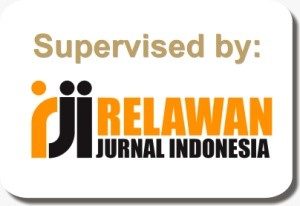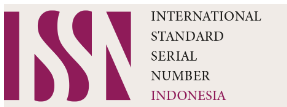ESP Students’ Preferences in Learning English: Face to Face Corrective Feedback vs Online Corrective Feedback
Abstract
ABSTRACT
The current study aims to explore the students’ preferences on face to face corrective feedback vs online corrective feedback in ESP class. It is an attempt to investigate if they prefer to be corrected directly face to face by teachers or they like to be provided online corrective feedback by the teachers. To do so, a questionnaire was distributed to a group of students who are taking English for Specific Purposes and also focus group discussion was used in order to find out their beliefs toward their corrective feedback preferences. Totally, 50 students who were taking ESP courses at State Polytechnic of Subang participated in this study. The results from the questionnaire analysis revealed that the students preferred their teachers to use face to face corrective feedback, with an overall mean (x̄ = 3,95) in learning effectiveness, (x̄ = 4,12) in learning accuracies, and (x̄ = 4,02) in learning experiences. The focus group discussion revealed the students’ beliefs in their corrective feedback preferences, they believed that the teachers should be able to guide their learning, use communicative ways, and encourage them by using their learning preferences. The study suggested that taking these preferences into consideration could help students to increase their confidence in learning English.
Keywords: Corrective Feedback, Face to face, Online, English Learning
References
Al-Okaily, R. (2013). Mobile learning and BYOD: Implementations in an intensive English program. Learning and Teaching in Higher Education: Gulf Perspectives, 10(2).
Al-Shehri, S. (2011). Proceedings from context in our pockets: Mobile phones and social networking as tools of contextualizing language learning. Paper presented at 10th World Conference on Mobile and Contextual Learning. Beijing, China.
Arslan, R.S. (2014). Integrating feedback into prospective English language teachers’ writing process via blogs and portfolio. The Turkish Online Journal of Educational Technology 13:1, 131-150.
Beare, P.L. (1989). The comparative effectiveness of videotape, audiotape and telecture. The American Journal of Distance Education 3, 57-66.
Bitchener, J., Young, S., & Cameron, D. (2005). The effect of different types of corrective feedback on ESL student writing. Journal of Second Language Writing 14, 191–205.
Chaudron, C. (1988). Second Language Classrooms: Research on Teaching and Learning. Cambridge, UK: Cambridge University Press
Chong, I. (2016). How students’ ability levels influence the relevance and accuracy of their feedback to peers: A case study. Assessing Writing 31, 1-11. doi.org/10.1016/j.asw.2016.07.002
Chen Hsieh, J. S., Wu, W. C. V. & Marek, M. W. (2017). Using the flipped classroom to enhance EFL learning. Computer Assisted Language Learning, 30(1/2), 1–21.
Chu, R. (2011). Effects of teachers’ corrective feedback on accuracy in the oral English of English- majors college students. Theory and Practice in Language Studies, 1(5), 454-459.
Corder, S. (1974). 'Idiosyncratic Dialects and Error Analysis'. In J. Richard (Ed.), Error Analysis: Perspectives on second Language Acquisition (pp. 158-171). Essex: Longman.
Dörnyei, Z. (2002). Questionnaires in second language research: Construction, administration, and processing. United States: Lawrence Erlbaum Associates.
Ellis R. (2009). Corrective feedback and teacher development. L2 Journal, (1), 3-18.
Ellis, R. (2010). A framework for investigating oral and written corrective feedback. Studies in Second Language Acquisition, 32, 335e349
Ferdian, N. R. (2016) Language Learning Strategies Used by International Students in Learning the Thai Language. Journal of Learning Innovation. Walailak University (79-93) Thailand.
Ferdian, N. R. (2017) Reflections on Digital Learning: Learning Strategies, Environments, and Opportunities. Rangsit Journal of Educational Studies. RJES Vol.4, No.2, (32-52)
Ferdian, N. R. (2019) Learning Strategies in Making Video Project Assignments in ESP Class. Linguists: Journal of Linguistics and Language Teaching, 5(1), 18–28.
Ferris, D. (1995). Students reactions to teacher response in multiple-draft composition classrooms. TESOL Quarterly, 29(1), 33-53.
Ferris, D. R. (2003). Response to student writing: Implications for second language students. Mahwah, NJ: Lawrence Erlbaum Associates.
Ferris, D. (2014). Responding to student writing: Teachers’ philosophies and practices. Assessing Writing, 19, 6-23.
Hedgcock, J., & Lefkowitz (1994). Feedback on feedback: Assessing learner receptivity to teacher response in L2 composing. Journal of Second Language Writing, 3(2), 141-163.
Hyland, K. & Hyland, F. (2006). Feedback on second language students’ writing. Language Teaching, 39, 83-101. http://dx.doi.org/10.1017/S0261444806003399
Jacobs, G. M. & Farrell, S. C. (2003). Understanding and implementing the CLT Paradigm. RELC Journal, 34(1), 5-30
Jin, C., & Lin, J. (2016). Corrective Feedback in SLA: Theoretical Relevance and Empirical Research Corrective Feedback in SLA : Theoretical Relevance and Empirical, https://doi.org/10.5539/elt.v9n11p85
Kirovska-Simjanoska, D. (2016). Do ESP Students Prefer Face-To-Face Instruction Over Digitally Embedded Instruction? Blogs vs Reports Debates vs Online Discussion. Procedia - Social and Behavioral Sciences, 232(April), 170–176. https://doi.org/10.1016/j.sbspro.2016.10.042
Lee, E. J. (2013). Corrective feedback preferences and learner repair among advanced ESL students. System, 41(2).
Lee, I. (2004). Error correction in L2 secondary writing classrooms: The case of Hong Kong. Journal of Second Language Writing, 13(4), 285-312.
Mahfoodh, O. H. A. (2016). “I feel disappointed”: EFL university students’ emotional responses towards teacher written feedback. Assessing Writing 31, 1-20.
McCleary, I. & Egan, M. (1989). Program design and evaluation: Two-way interactive television. The American Journal of Distance Education, 3, 50-60.
Montgomery, J.L., & Baker, W. (2007). Teacher-written feedback: Student perceptions, teacher self-assessment, and actual teacher performance. Journal of Second Language Writing 16, 82–89.
Nelson, M. M., & Schunn, C. D. (2009). The nature of feedback: How different types of peer feedback affect writing performance. Instructional Science, 37, 375–401. doi:10.1007/s11251-008-9053-x.
Rahimi, M., & Zhang, L. J. (2015). Exploring non-native English-speaking teachers’ cognitions about corrective feedback in teaching English oral communication. System, 55, 111-122. https://doi.org/10.1016/j.system.2015.09.006
Richards, J. C. (2006). Communicative language teaching today. New York: Cambridge University Press.
Sangeetha, S. (2016). Edmodo and Padlet as a collaborative online tool in enriching writing skills in language learning and teaching. Global English-Oriented Research Journal, 1(4), 178–184.
Sonner, B. (1999). Success in the capstone business course-assessing the effectiveness of distance learning. Journal of education for Business, 7, 243-248.
Tavakoli, H. (2012). A Dictionary of Research Methodology and Statistics in Applied Linguistics. United States: Rahnama.
Thi, N., & Thao, T. (2017). European Journal of English Language Teaching Teachers ’ Corrective Feedback on English Students ’ Writing, 177–197. https://doi.org/10.5281/zenodo.437760
Wang, W. (2014). Students’ perceptions of rubric-referenced peer feedback on EFL writing: A longitudinal inquiry. Assessing Writing, 19, 80-96.
Williams, J., & Jasmine, G. (2003). Providing feedback on ESL students’ written assignments. TESL-EJ, 10(4), 1-6.
Zhang, Z. (2017). Student engagement with computer-generated feedback: A case study. ELT Journal, 71, 317e328.
Zhang, Z., & Hyland, K. (2018). Student engagement with teacher and automated feedback on L2 writing. Assessing Writing, 36, 90e102.
Zheng, Y., & Yu, S. (2018). Student engagement with teacher written corrective feedback in EFL writing: A case study of Chinese lower-proficiency students. Assessing Writing, 37, 13e24.
Authors retain copyright and grant the journal right of first publication with the work simultaneously licensed under a Creative Commons Attribution-ShareAlike 4.0 International License (CC BY-SA 4.0) that allows others to share the work with an acknowledgment of the work's authorship and initial publication in this journal.
Authors are able to enter into separate, additional contractual arrangements for the non-exclusive distribution of the journal's published version of the work (e.g., post it to an institutional repository or publish it in a book), with an acknowledgment of its initial publication in this journal.
Authors are permitted and encouraged to post their work online (e.g., in institutional repositories or on their website) prior to and during the submission process, as it can lead to productive exchanges, as well as earlier and greater citation of published work (See The Effect of Open Access).






